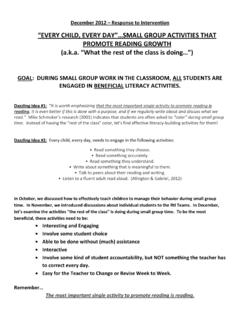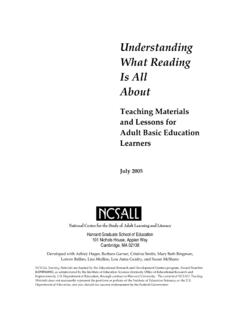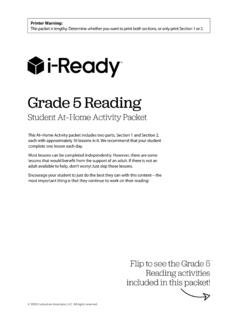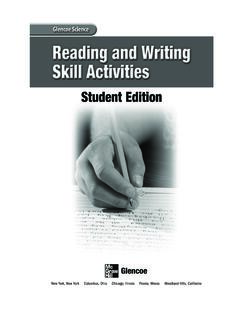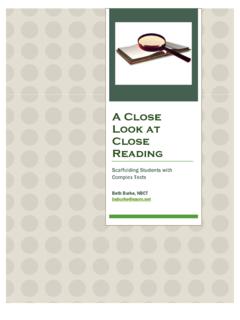Transcription of Reading comprehension: Progression in objectives …
1 Progression in objectives , linked teaching activities 1 Reading comprehension : Progression in objectives suggested teaching activities and approaches This section identifies the progress within the different strands, pulling together the year by year objectives , to help make the next step more obvious. It also includes some suggestions for teaching the objectives . No school is likely to adopt all the suggested approaches, but they may help in identifying and establishing consistency in the teaching of comprehension across different year groups. Use this section to identify a specific objective or approach to teaching an element of the comprehension curriculum, or to make an objective easier or harder in order to differentiate learning in a class. Progression in objectives , linked teaching activities 2 Section contents Pages How the pages work 3 Develop positive attitudes 4 - 9 Skills and Strategies to read for understanding 10 23 Understand the vocabulary used in texts 24 - 27 Express, record and present their understanding 28 - 39 Understand the whole text 40 51 Retrieve information from texts 52 60 Inferential understanding 61 73 Reading to find out 74 - 82 Progression in objectives , linked teaching activities 3 How the pages work Theme and strand headings followed by general introduction to the theme.
2 Identifying important leadership and teaching considerations Whole school approaches and common activities for developing these skills Suggestions for establishing consistent practices across a school Progression within the objectives and teaching suggestions linked to the objective Progression in objectives , linked teaching activities 4 Develop positive attitudes to Reading Take pleasure in Reading : Develop positive attitudes to Reading Read independently and in groups. Enjoy listening to books read to them Discuss books: Participate in discussion about what is read to them, taking turns and listening to what others say Extend their range of Reading Our aim is to ensure not only that children can read but that they do read. We know that if children are enthusiastic, independent readers by the time they leave primary school, and this is sustained into their teenage years, then this has a strongly positive impact on their life chances and educational success.
3 We believe that developing the ability to understand is critical to becoming a committed reader, for if you don t understand why would you want to read? Developing positive attitudes depends on this understanding but also on the diet of texts we use with children. We need to read regularly to our classes, whatever their age. We need to use whole books not just extracts, so readers experience the pleasures of a beginning, middle and end of a text, of seeing how exciting situations are resolved and how books can open us up to new worlds and strange possibilities. We need to enthuse children about books, so we need to be committed readers ourselves, knowledgeable about children s books, and adept at exploiting opportunities created by film dramatisations of children s books, by world book day and other celebrations, and by creating exciting, engaging opportunities for Reading through our classroom work.
4 Progression in objectives , linked teaching activities 5 Whole school approaches and common activities for developing positive attitudes to Reading Identify a Reading curriculum which is explicitly taught in all year groups Ensure the texts used with children are as rich as possible only the best texts will do! Read regularly to children from a range of texts of different sorts and lengths, in order to give all children access to high quality material Use complete texts with children as often as possible with older children short stories are ideal teaching texts Use the school and local libraries to promote Reading and support readers, ensure classroom book areas and displays encourage interest, Reading success and good Reading habits Have regular book themed assemblies, celebrate Reading in all its different guises, enjoy world book day and other celebrations of Reading Run out of class book groups which cross year group boundaries Maintain interesting book areas and displays in classrooms and corridors to entice children to want to read Provide advice to parents on how to engage with the Reading of older children.
5 Introducing some of the reciprocal Reading approaches Monitor children s independent Reading Celebrate Reading , involving the whole school community in events which raise the profile of Reading and engage children in it Progression in objectives , linked teaching activities 6 Take pleasure in Reading : Develop positive attitudes to Reading and enjoy listening to books read to them Progression 1 Select books for personal Reading and give reasons for choices 2 Read and listen to whole books, make choices for their personal Reading 3 Sustain their Reading for enjoyment and to find out 4 Read independently complete short texts and sections from information books 5 Listen to texts read to them. Read favourite authors and choose books to read on the recommendation of others 6 Listen to texts read to them and sustain their Reading of longer and more challenging texts Read regularly to children of all ages throughout the school Talk about books regularly share enthusiasms, new finds, interesting snippets Have regular choosing times to replenish the classroom book stock Ensure book corners are enticing and welcoming.
6 Give children time to access them Make sure non-fiction texts are not simply props in cross curricular displays but are used to promote Reading Celebrate Reading successes Encourage independent Reading and Reading at home Progression in objectives , linked teaching activities 7 Read independently and in groups. Enjoy listening to books read to them This is a universal objective and therefore not broken down into specific year objectives . In all years Read independently and in groups. Enjoy listening to books read to them Provide time for children to select and read books both independently and in groups Read with children as part of guided Reading Encourage children s independent Reading at home, where possible let them borrow books and talk about their home Reading in class Home Reading any Reading is better than none!
7 Ensure children of all ages are read to regularly Be ambitious with the texts that are read to the class to extend their knowledge of books and authors, beyond those that they might meet independently Where possible make multiple copies of a text that you are Reading to the class available for children to examine, re-read or borrow Share enthusiasms and new finds Use the school and local libraries frequently Ensure that a class book area remains an attractive, exciting place, change displays regularly, bring new books in, highlight available books to the class Progression in objectives , linked teaching activities 8 Discuss books: Participate in discussion about what is read to them, taking turns and listening to what others say Progression 1 Discuss books they like and give reasons for choices 2 Justify their choices of books and their preferences from the books they have read or have had read to them 3 Discuss why they like particular books or authors with others, giving reasons 4 Describe and review their own Reading habits 5 Talk about books referring to details and examples in the text 6 Discuss their personal Reading with others and articulate their personal response to their Reading , identifying how and why a text affects the reader There are overlaps between this element of the Develop positive attitude to Reading strand and discussion as part of the express, record and present understanding strand.
8 Here discussion is more general perhaps more geared towards expressing thoughts and preferences about a text, rather than using discussion as a means of teasing out understanding. Obviously these book conversations are not mutually exclusive. Provide time for discussion about books; let children talk about books and make recommendations to each other Make links between children s own experiences and the events and information they encounter in texts Encourage children to link texts to others that they have read or heard Encourage children to express and articulate personal opinions about texts Make it clear that alternative interpretations and views about texts are acceptable, as long as disagreements don t become personal or argumentative Progression in objectives , linked teaching activities 9 Extend their range of Reading Progression 1 Select books to read and listen to 2 Make choices from a selection of texts to hear and to read themselves 3 Extend the range of books read by browsing and selecting texts, including poetry.
9 To read independently 4 Develop their Reading stamina as they read longer texts 5 Plan personal Reading goals which reflect their interests and extend their range 6 Develop their Reading stamina and complete the independent Reading of some longer texts. This strand is about extending children s Reading repertoire, range and stamina. Whilst it is important to acknowledge, encourage and celebrate children s enthusiasms with Reading , the teacher s role is also to extend their range and ability to read texts of greater length. Compare the texts and authors read in different year groups to ensure a rich, varied diet of texts Review the range of material read as part of topic work and in other curriculum subjects Use Reading diaries to record Reading achievements, note suggested titles and set personal Reading goals Provide children with choice of Reading material Enable children to browse from a range of texts Suggest follow up texts to supplement class or personal Reading Progression in objectives , linked teaching activities 10 Skills and strategies to read for understanding Use prior knowledge to support understanding Check that books make sense to them Ask questions to improve their understanding Skim.
10 Scan and read closely Use strategies to locate or infer the meaning of unfamiliar words Annotate text Visualise their understanding of what they read Make predictions Summarise understanding Adapt Reading strategies for different purposes or according to the text type We know that readers who are good at understanding the texts they read take an active approach to Reading . They expect texts to make sense to them and when they do not, they take steps to sort out the difficulties. Good readers think about what they know about a topic before they read, frequently check their own understanding, for example by making predictions and brief summaries, and ask questions to clarify things which are not obvious to them. They do not read on when they do not understand, unless they are confident that an explanation will soon become clear. Whilst the 2014 Programme of Study identifies and highlights some of these important skills, others are not mentioned in the curriculum yet these skills are fundamental to making children better readers.
